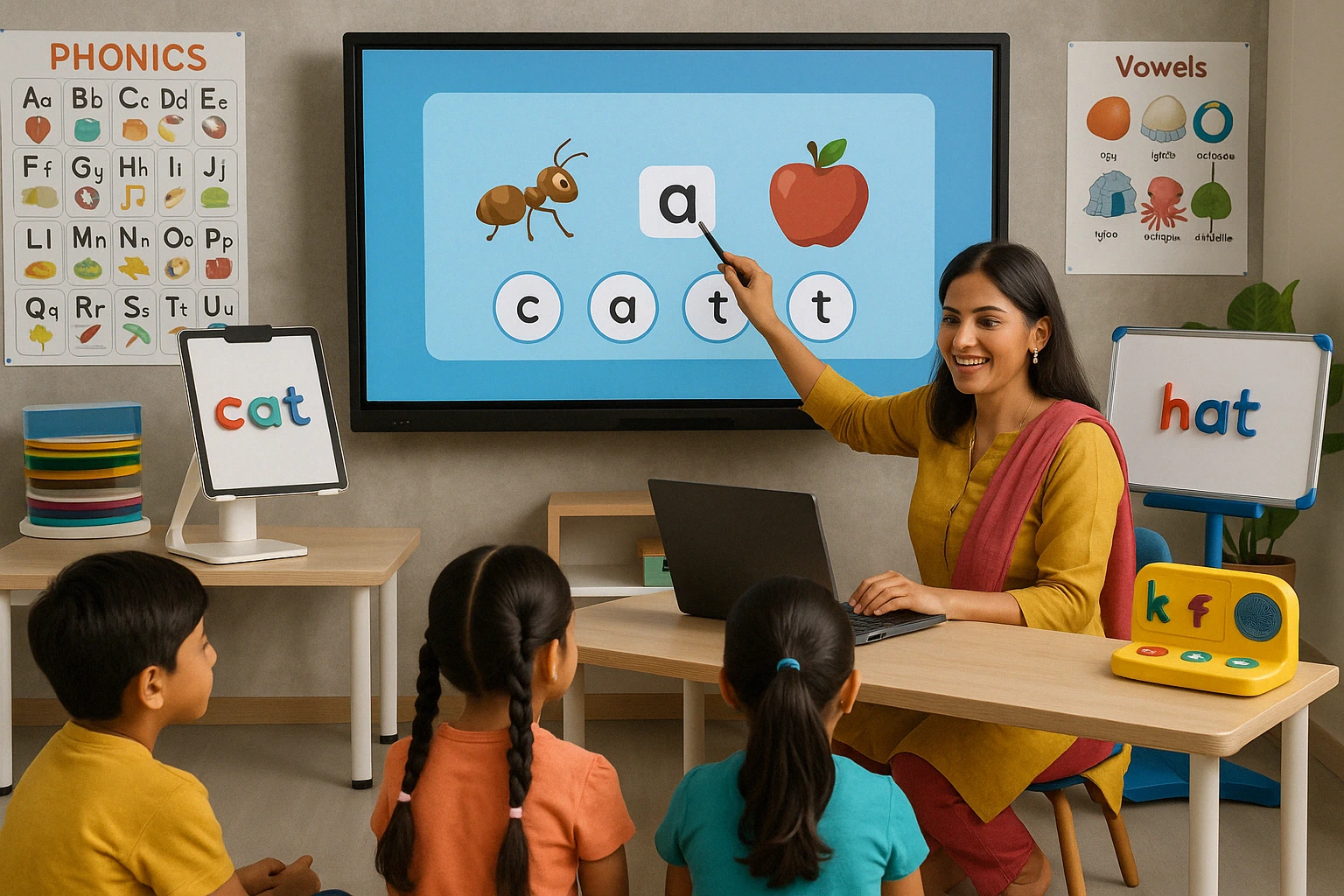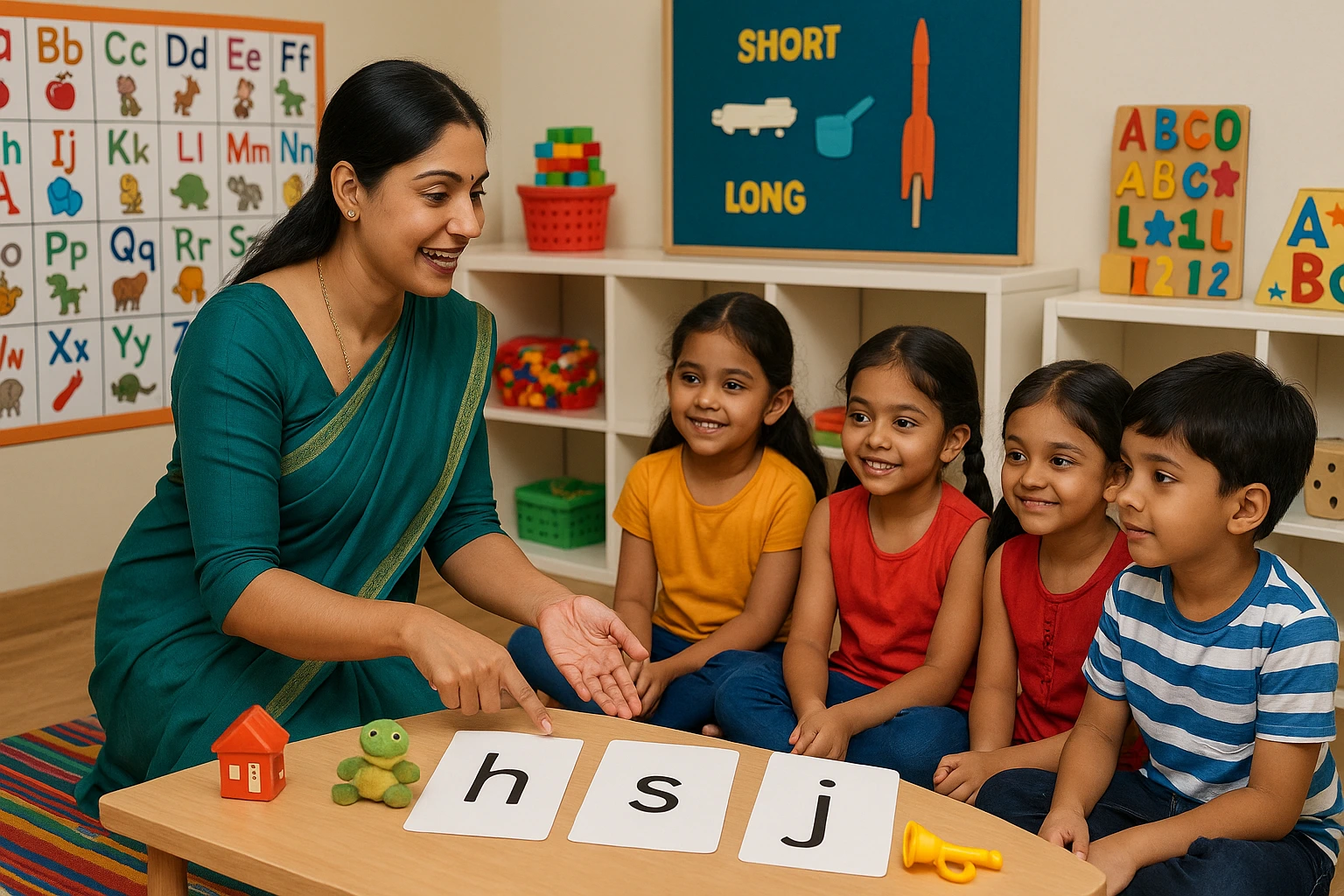Empower Early Readers through Kindergarten Phonics Reading
Empower Early Readers through Kindergarten Phonics Reading
Building a strong reading foundation kicks off with effective Kindergarten Phonics Reading. Through creative activities and sound-based learning, children begin associating letters with sounds effortlessly. Empower Early Readers through Kindergarten Phonics Reading as it helps them develop decoding skills that lead to reading success.
With the correct techniques, Kindergarten Phonics can make early reading enjoyable and lead to confidence building in every child.
Table of Content
Building Strong Sound-Letter Connections Early
In early literacy development, Building Strong Sound-Letter Connections Early lays a robust foundation for confident readers. Kindergarten Phonics Reading focuses on helping children associate sounds with letters accurately, a skill necessary for adept reading and writing. Strengthening these associations from the beginning makes future learning quicker, easier, and more gratifying.
Importance of Building Strong Sound-Letter Connections Early
Sound-Letter Connections or Phonemic awareness is the ability to perceive, recognize, and work with individual sounds in words. It is a fundamental pre-reading skill that is directly associated with success in Kindergarten Phonics.
Key reasons that make phonemic awareness important includes:
Sound Identification
Children must pick up and differentiate between sounds before they can relate them to letters.
Reading Fluency
Adept phonemic skills speed up decoding, leading to smoother reading experiences.
Spelling Accuracy
Sound pattern recognition helps children spell words correctly.
Early Involvement
Learning phonemic awareness early helps recognize and support struggling readers before gaps widen.
Without phonemic understanding, Kindergarten Phonics Reading can become discouraging for young learners, thus losing their confidence.
How Teacher Training Enhances Phonics Instruction
Effective Kindergarten Phonics relies on skilled teachers who understand how young minds learn sounds and letters.
Teacher training plays a major role by:
Providing Organized Methods
Training programs include stepwise phonics instruction, checking that no learning phase is skipped.
Adjusting to Learning Styles
Trained teachers can modify activities to suit different learners, keeping phonics lessons interesting.
Offering Timely Support
Early clues of difficulty are easier to identify, allowing teachers to offer additional guidance where required.
Using Research-Based Techniques
- Training ensures teachers apply proven methods for sound-letter connections, making phonics sessions highly effective.
- By strengthening teacher expertise, Kindergarten Phonics becomes more systematic and enjoyable for children.
Fun and Effective Methods to Teach Sound-Letter Mapping
Teaching sound-letter mapping can be exciting when done creatively.
In Kindergarten Phonics Reading, playful activities reinforce strong learning habits:
Letter-Sound Games
Coordinating games where children pair letters with objects beginning with that sound (e.g., ‘p’ with ‘pencil’).
Multi-Sensory Activities
Tracing letters in sand, shaping them with clay, or air-writing them while saying the sound loudly.
Singing and Chants
Songs and poems that focus on particular sounds help children recall letters easily.
Story Time with Sound Focus
Reading stories and emphasizing specific sounds in words builds listening and decoding skills naturally.
Sound Sorting
Giving children pictures and asking them to categorize based on initial or ending sounds.
These fun activities keep learners active and engrossed, making Kindergarten Phonics an interactive process that builds enduring skills.

Phonics Tools that Spark Reading Confidence
Building a strong start in reading depends heavily on providing the right phonics tools and support. Kindergarten Phonics becomes much more effective when interactive Phonics Tools that Spark Reading Confidence are used. These tools help young learners identify sounds, blend words, and read with more confidence.
Interactive Tools and Visual Learning Aids for Phonics Learning
Interactive tools and visual learning aids bring letters and sounds to life. Rather than just memorizing, children actively immerse themselves in the learning material, leading to improved retention.
Digital Phonics Games
Online games planned for Kindergarten Phonics familiarize letters, sounds, and word structure through playful interaction.
Flashcards and Charts
Bright, multicolored flashcards and sound representations help children relate visuals with letter sounds, amplifying key Kindergarten Phonics Reading skills.
Storytelling with Visual Cues
Using storybooks with pictures and highlighted sounds assists children in focusing on phonics while enjoying a story.
Interactive Phonics tools that Spark Reading Confidence turn lessons into memorable experiences that children look forward to.
Blending Sounds, Decoding, and Sight Word Strategies
Mastering sight words is are essential pillar of Kindergarten Phonics.
Blending Sounds
Children practice combining individual letter sounds to create simple words, building proficiency stepwise. Tools like blending boards or moveable letter kits make this hands-on and engaging.
Decoding Exercise
Through decoding practice, learners interpret unknown words by splitting them into sounds, promoting their analytical thinking in Kindergarten Phonics.
Sight Word Games
Entertaining activities like bingo or memory-matching games help children instantly recognize high-frequency words, facilitating reading accuracy and building automaticity.
These Phonics Tools that Spark Reading Confidence allow children to move from simple sound recognition to confident word reading effortlessly, strengthening every facet of Kindergarten Phonics Reading.
How Trained Teachers Select and Use the Right Resources
Teachers play a key role in ensuring that Kindergarten Phonics Reading tools are used effectively.
Their training helps them:
Assess Individual Needs
Trained educators understand that each child progresses differently. They choose phonics tools based on learning styles and developmental stages.
Plan Structured Lessons
Instead of random activities, teachers create a clear sequence—from introducing sounds to blending words—aligning every tool with learning goals.
Adapt and Modify Tools
Skilled teachers modify games and tools to challenge fast learners or assist those who require more support, keeping Kindergarten Phonics Reading convenient for all.
Encourage Consistency
Standard, integrated use of phonics tools ensures progressive skill building, making reading advancement smoother and more natural.
With the fitting tools and adept guidance, Kindergarten Phonics transforms from a challenge into an exciting, confidence-building journey for young readers.

Source: leader.pubs.asha.org
Role of Trained Teachers in Early Literacy Success
Developing powerful reading skills commences with effective early literacy instruction. Kindergarten Phonics is one of the most important aspects of this early learning process, where young learners relate letters with sounds to form words. Trained and certified teachers play a noteworthy role in making Kindergarten Phonics Reading a smooth and flourishing journey for children.
Institutes like Vidhyanidhi Education Society (Govt. Regd.), offering a specialized Phonics Course, ensure that teachers are well-equipped to make a real difference in classrooms.
Let us see the significance of the Phonics Teacher Training Course and the Role of Trained Teachers in Early Literacy Success.
Why Professional Training Improves Phonics Delivery:
- Teachers who undergo a structured Phonics Course understand phonetic principles in depth.
- They learn research-based methods to teach sounds systematically and clearly.
- Professional training helps teachers plan lessons that focus on both sound recognition and blending techniques.
- Through innovative and practical techniques, children grasp Kindergarten Phonics Reading faster, leading to improved reading fluency.
- Trained teachers can easily identify learning gaps and modify their teaching approaches as required.
- Impact on Fluency, Comprehension, and Vocabulary
- Proficient Kindergarten Phonics skills help children read words accurately and quickly.
- With mastery of phonics, young learners move towards smoother fluency and deeper comprehension.
- Vocabulary grows because children can decode new words independently through sound knowledge.
- By mastering Kindergarten Phonics, children not only read better but also develop a genuine love for reading, which further boosts language skills.
- Real Classroom Outcomes from Phonics-Trained Educators
- Classrooms led by teachers trained through a Phonics Course show higher reading success rates.
- Students become confident readers early, which boosts their overall academic performance.
- Teachers use ingenious, practical activities to make Kindergarten Phonics Reading fun, leading to higher student engagement.
- Regular assessments and phonics games used by trained teachers help track and reinforce learning consistently.
Institutions like Vidhyanidhi Education Society (Govt. Regd.) ensure that educators acquire the right knowledge and training through their Phonics Course. Investing in professional phonics training means creating classrooms where every child has the opportunity to become a skilled and enthusiastic reader.
Boost young readers’ skills—join Vidhyanidhi’s Phonics Teacher Training Course!
Click Here, to download the brochure about Phonics Teacher Training Course!
Call or Whatsapp on +919869866277 / +919869546913, for Admission Details of Phonics Teacher Training Course.
FAQs
What Skills do Children Gain from Phonics Reading Early on?
Children develop decoding, spelling, sound recognition, vocabulary expansion, and reading mastery through early phonics reading.
Why is Phonics Essential in Early Childhood Classrooms?
Phonics builds a strong foundation for literacy by associating sounds to letters, supporting early reading, spelling, and comprehension.





